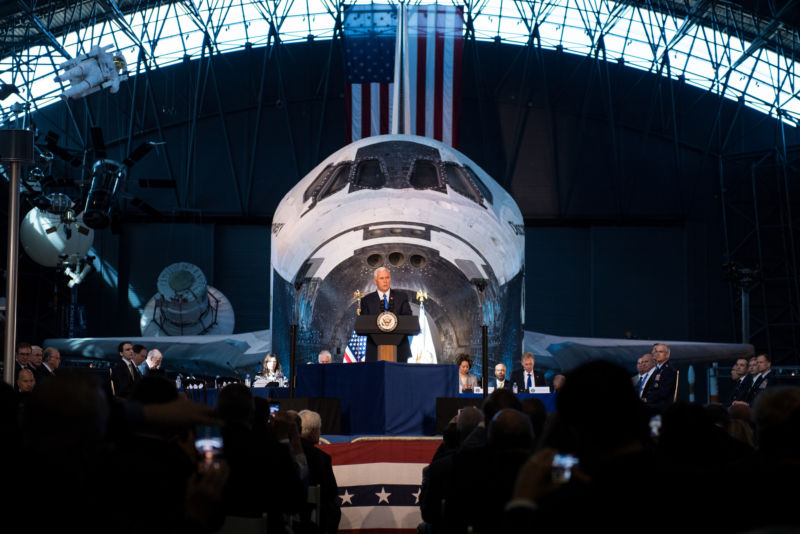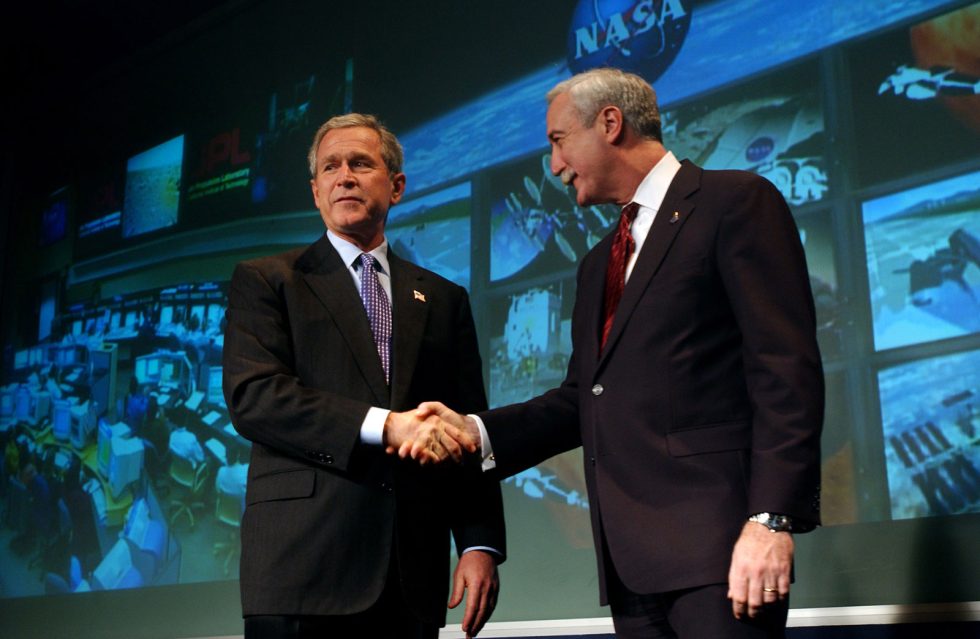Are we really going to the Moon? History isn’t kind to presidential plansPresident Trump says NASA will land humans on the Moon. But you should be skeptical.
ERIC BERGER - 10/6/2017, 2:58 PM
 Vice President Mike Pence speaks at Thursday's meeting of the National Space Council in front of a space shuttle
Vice President Mike Pence speaks at Thursday's meeting of the National Space Council in front of a space shuttlePresident Kennedy, of course, got it right when it came to NASA. He established a big, bold goal for the nation's new space agency, provided ample resources, and then let the engineers get to work. This led to one of humanity's greatest achievements of all time—walking on another world.
Kennedy had ulterior motives, naturally. From a policy perspective, going to the Moon wasn't really about human exploration so much as it was demonstrating the technical superiority of the United States to the rest of the world during the Cold War. As space exploration hasn't quite aligned so neatly with national security goals since the 1960s, funding levels have shrunk. And this has led to NASA being confined to low-Earth orbit for human exploration, first with the space shuttle and now the International Space Station.
For a time, low-Earth orbit was enough. After Richard Nixon greenlighted NASA's development of the space shuttle in 1972, Gerald Ford and Jimmy Carter were content to let the space program play out more or less in the background of their administrations. Although Ronald Reagan set NASA on the course to what would eventually become the International Space Station, he too was content with staying near Earth. Yet since Reagan, most presidents have looked longingly, and fruitlessly, back toward deep space. In light of the Trump administration's goal of
returning to the Moon, we offer a review of other presidential space plans.
Space Exploration InitiativePresident George H.W. Bush took office in 1989, about three years after the space shuttle Challenger accident, amid a sense that NASA needed a bold new direction. In February of that year, he established the National Space Council and, like President Trump has done, installed his vice president (Dan Quayle) as its chairman. Quayle worked toward setting a new course for NASA.
By July 20, 1989—on the 20th anniversary of the Apollo 11 Moon landing—Bush was ready to disclose those plans. He announced the
Space Exploration Initiative, a long-range commitment toward the human exploration of deep space. Bush outlined the plans that would follow the completion of Space Station Freedom in the 1990s.
"And next, for the new century: back to the Moon; back to the future," he said. "And this time, back to stay. And then a journey into tomorrow, a journey to another planet: a manned mission to Mars."
What happened next was not particularly pretty. As NASA wasn't entirely on board with the plans, its administrator, Dick Truly, resisted the will of the National Space Council. NASA's own estimates (the infamous
90-day study) suggested the plan might cost half a trillion dollars or more, and Congress had no appetite for such a budget. (The book
Mars Wars chronicles all of the fallout in gory detail.) Needless to say, NASA didn't go back to the Moon, or on to Mars. Under President Clinton, it continued development of the space station, and plans of deep space would be put on hold for a decade and a half.
Vision for Space ExplorationLike his father, President George W. Bush found himself struggling to find a direction for NASA after the loss of space shuttle Columbia in 2003. Like his father, Bush envisioned a bold plan to send humans back to the Moon, where they would learn how to operate in deep space and then go on to Mars. This became the Constellation program.
"Establishing an extended human presence on the Moon could vastly reduce the costs of further space exploration, making possible ever more ambitious missions," Bush
said. "Lifting heavy spacecraft and fuel out of the Earth's gravity is expensive. Spacecraft assembled and provisioned on the moon could escape its far lower gravity using far less energy, and thus, far less cost."
 President George W. Bush and NASA Administrator Sean O’Keefe on January 14, 2004, the day the Vision for Space Exploration was announced.
President George W. Bush and NASA Administrator Sean O’Keefe on January 14, 2004, the day the Vision for Space Exploration was announced.This vision was well received in the aerospace community, but then three bad things happened. NASA's new administrator, Mike Griffin, picked a large and particularly expensive architecture—the Ares I and Ares V rockets—to get humans back to the Moon. International partners were largely ignored. And then neither the president or Congress fought for the full funding the program would need to survive.
By the time President Obama came into office, development of new vehicles was flagging. The notion of crew landings on the Moon by 2015 seemed way out of reach. The Constellation program was on life support. (Paul Spudis has detailed the downfall of the Vision for Space Exploration in a series of
blog posts).
Space exploration in the 21st centuryObama canceled Constellation after a blue-ribbon commission he appointed, led by former Lockheed Martin Chairman Norm Augustine, found it woefully behind schedule and over budget. Augustine's committee suggested that NASA be given a clear goal for human exploration and the resources to accomplish that goal.
And that's exactly what didn't happen. Initially, Obama
called for investment into new propulsion technologies that would zip astronauts through the Solar System at higher velocity, thereby reducing the risk of health problems due to microgravity. By the end of this decade, when NASA might begin to need big rockets, Obama's advisers believed the private sector—either United Launch Alliance, SpaceX, or someone else—would be ready to build them. He gave his
principal space policy speech in April 2010.
But Congress hated this plan. It would further diminish the roles of the ten NASA field centers and cede more power and money to upstart companies like SpaceX. Congress fought back and forced the president to accede to building the costly Space Launch System rocket as well as continue development of the Orion space capsule. Congress got its big, Apollo-like space program back. (I have written extensively about the Journey to Mars, and its failings, in the
Adrift series).
This rocket needed somewhere to go. And instead of focusing on the Moon, Obama has directed his administrator, Charles Bolden, to go first to an asteroid, and then on to Mars. Thus began the "Journey to Mars," which would see humans land on the Red Planet in the 2030s. But this "journey" struggled to gain wide traction in the aerospace community, where skepticism abounded due to the program's lack of a clear plan, timeline, or dedicated funding.
Leading the Next FrontierThis year, after President Trump's election, he decided to reinstate the National Space Council, with Pence at his head. Although there had been strong hints of intent in recent months, only this week did Pence
formally declare a goal for human exploration: a Moon-then-Mars plan. In this vision there were echoes of both the Bush plans for deep space exploration.
"We will return American astronauts to the Moon, not only to leave behind footprints and flags, but to build the foundation we need to send Americans to Mars and beyond," Pence said Thursday, at the outset of the space council meeting. "The Moon will be a stepping-stone, a training ground, a venue to strengthen our commercial and international partnerships as we refocus America’s space program toward human space exploration."
What Pence, or any other member of the space council, did not do on Thursday was discuss how Americans would get to the Moon or whether NASA's budget would be increased to do so. The reality of the matter is that, if NASA continues to build the Space Launch System and Orion, at best, it could afford a small space station near the Moon within about a decade.
Former space shuttle program manager Wayne Hale, who worked at Johnson Space Center during both of the Bush announcements, as well as President Obama's policy speech, offered a pithy summary of the situation on Twitter after Thursday's meeting. "Bold talk at Nat'l Space Council today but we've heard it before," he
tweeted. "What counts will be resources ($) and long term commitment."
To find out if we're really going back to the Moon, we'll need to see a concrete plan for doing so, adequate funding, and some kind of indicator that this administration and future ones are in this for the long haul. That wasn't going to happen at the first meeting of the National Space Council, to be sure. But until it does, the aerospace community will retain a healthy skepticism about deep space exploration.
Source:
Are we really going to the Moon? History isn’t kind to presidential plans